Papers by Danjuma Abdu Yusuf
Energy Conversion and Management, Sep 1, 2023

Journal of Regional and City Planning
This study took the ‘origin-pattern-function’ of landscape progression as the central theoretical... more This study took the ‘origin-pattern-function’ of landscape progression as the central theoretical framework and conducted a systematic study on the evolution of open-space landscape patterns in Habe cities, situated between the river Niger and the river Benue in northern Nigeria. This study aimed to explore the embedded landscape cosmology in Hausaland and the origins of its historic mythology. A descriptive research and review approach was adopted, to explain and interpret prevailing practices, existing circumstances, attitudes, reasons, and on-going processes. It unveils the planning of open spaces and houses according to an ancient cosmology that organized towns during the Habe Hausa Dynasty. The open spaces appear to be a sphere of convergent and divergent forces that maintain a delicate balance, whereas the outcrop hills of central Hausaland are domicile places with religious appeal and better defensibility. Further, the physical effects of Islamic influence are visible in the ...
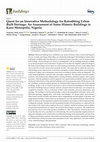
Buildings
Historical buildings have inhabited every epoch of history. Some of these built legacies are now ... more Historical buildings have inhabited every epoch of history. Some of these built legacies are now in ruins and dying whilst others are somewhat undamaged. Knowledge of conservation techniques available today has allowed us to understand more innovative ways of conserving the built heritage. Such techniques are, however, incompatible with the building materials available in our historical epoch and environment. People seek to reclaim the forgotten cultural heritage in the midst of the heritage conservation era while bearing in mind that previous work seldom takes into account the inventive preservation methods of today. This study aims to explore the innovative built heritage conservation practice in the Kano metropolis, to detect deterioration and incorporate traditional wisdom and contemporary innovation according to modern urban development. The study adopted qualitative research with a descriptive approach. The descriptive research explains, examines, and interprets prevailing pra...
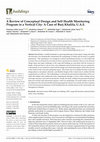
Buildings
Burj Khalifa, a notable landmark in a growing landscape of skyscrapers, along with other tall str... more Burj Khalifa, a notable landmark in a growing landscape of skyscrapers, along with other tall structures, has dramatically transformed the morphology of Dubai and elevated it to global prominence. This masterpiece was designed to attract international interest, as it diversifies the economy from an oil-based one towards one that is tourist-and servicebased. However, the foremost design input and major challenges of the super-tall building are associated with the increase in height, which put them at risk of wind- and earthquake-induced lateral loads and user satisfaction. Consequently, it was essential to study both the design and construction phases of the tallest towers in the context of the wind and earthquake impact. This study aims to revalidate the three structural design phases; conceptual, schematic, and detailed design of this vertical city to confirm that the requirements are achieved. The methodology is a theoretical and analytical elaboration of the case study that obtai...

Urban Science
The significance of urban landscapes in the current era of concern for a sustainable built enviro... more The significance of urban landscapes in the current era of concern for a sustainable built environment can never be overemphasized. The study explores the landscape features and typologies of some urban environments within Kano to understand the management effectiveness of urban landscapes in the Kano metropolitan area. At least two wards were purposively selected each from the eight metropolitan local government areas due to their urban landscape and land use. Focus group discussion (FGD) sessions were carried out through with prominent elders and “Masu Unguwanni” (village/ward heads) of each of the sampled wards as well as direct assessments of their physical characteristics to justify the general landscape progression in support of documentation for the present and future generation. The study unveils the layout typology, the scenic points and the ecological and cultural landscapes in the sampled districts. It further reveals that the historic urban forms in Kano are degrading wi...
Atmospheric Pollution Research, 2021
The paper synthesis the current problems and suggest prospects solution in planning and developme... more The paper synthesis the current problems and suggest prospects solution in planning and development of Urban Land uses, in Kano Metropolis. It similarly presents the historical theories of urban land design and its development with a comparative analysis within Kano Metropolis visa-vise to the concept of city traditional patterns in (3) distinct regions in Nigeria and related it to modern concepts of city patterns. Similarly it reflects on the ideal of modern garden city movement approach, the satellite towns concepts were presented and recommended for scrutiny and implementation to improve the standard of our environment as well it reflection to modern time as social responsibility to all stakeholders in the planning and development of urban environment.
Scientific African, 2019
This is a PDF file of an article that has undergone enhancements after acceptance, such as the ad... more This is a PDF file of an article that has undergone enhancements after acceptance, such as the addition of a cover page and metadata, and formatting for readability, but it is not yet the definitive version of record. This version will undergo additional copyediting, typesetting and review before it is published in its final form, but we are providing this version to give early visibility of the article. Please note that, during the production process, errors may be discovered which could affect the content, and all legal disclaimers that apply to the journal pertain.

Atmospheric Pollution Research, 2021
Maritime transport has widely been used throughout the record history, and yet is the major sourc... more Maritime transport has widely been used throughout the record history, and yet is the major source of toxic pollutants to the atmosphere. Bearing this in mind, the effect of biodiesel on regulated and unregulated toxic pollutants with high-efficiency post-treatment (HePT) device from marine diesel engine were investigated at various engine loads. Organic carbon (OC), elemental carbon (EC), gaseous emissions, soot particle number and size distributions, polycyclic aromatic hydrocarbons (PAHs), n-alkanes species, trace metals and fatty acid methyl esters, were quantified and analyzed. The results showed that all the regulated gaseous emissions were within the standard limits, except for CO emission at idle mode. This was inconsistent to the result found with unregulated emissions. For unregulated emission factors (EFs), PM 2.5 species were dominated by OC, and similar proportion was observed with soot-EC using HePT device fueled with B25 and B50. The B25 and B50 EFs of total-PAHs were decreased from 11.7% to 54.8% compared to B0 at all engine loads. The dominant PAHs and 2-to 5ring species, were decreased substantially when using B50. Both fuel blends recorded a definite outline by dodecane, tetradecane and hexadecane at low load, whereas ~68.3% average reduction was observed with these n-alkane species at high load. The major metals present in lubrication oil were Ca, Zn, P, Mg, V, Si and Fe. These metals were 3 times higher than B0 metals. The accumulation mode particles rise with the load increase and the peaks gradually move to large particle size.

Maritime transport has widely been used throughout the record history, and yet is the major sourc... more Maritime transport has widely been used throughout the record history, and yet is the major source of toxic pollutants to the atmosphere. Bearing this in mind, the effect of biodiesel on regulated and unregulated toxic pollutants with high-efficiency post-treatment (HePT) device from marine diesel engine were investigated at various engine loads. Organic carbon (OC), elemental carbon (EC), gaseous emissions, soot particle number and size distributions, polycyclic aromatic hydrocarbons (PAHs), n-alkanes species, trace metals and fatty acid methyl esters, were quantified and analyzed. The results showed that all the regulated gaseous emissions were within the standard limits, except for CO emission at idle mode. This was inconsistent to the result found with unregulated emissions. For unregulated emission factors (EFs), PM 2.5 species were dominated by OC, and similar proportion was observed with soot-EC using HePT device fueled with B25 and B50. The B25 and B50 EFs of total-PAHs were decreased from 11.7% to 54.8% compared to B0 at all engine loads. The dominant PAHs and 2-to 5ring species, were decreased substantially when using B50. Both fuel blends recorded a definite outline by dodecane, tetradecane and hexadecane at low load, whereas ~68.3% average reduction was observed with these n-alkane species at high load. The major metals present in lubrication oil were Ca, Zn, P, Mg, V, Si and Fe. These metals were 3 times higher than B0 metals. The accumulation mode particles rise with the load increase and the peaks gradually move to large particle size.
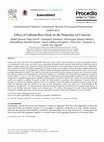
Procedia Manufacturing, 2019
In the recent years, there have been considerable efforts all over the world to reuse by-products... more In the recent years, there have been considerable efforts all over the world to reuse by-products in order to sustainably conserve our environment. In this sense, rice husk is also an agricultural bi-product and its ash after being burnt has widely been used to replace Portland cement in the construction industry due to the fact that it is rich in pozzolanic content. However, no studies have been conducted to identify the definite temperatures to which rice husk can be heated to produce the perfect qualities required for enhancement of concrete. This prompted us to find out whether utilizing ground unburnt rice husk would as well be fit to be used in partial replacement of cement. This would save time and other resources used in heating rice husk to ash. This study evaluates how different contents of rice husk added to concrete may influence its workability, water absorption and compressive strength of concrete with 0, 1.5, 2.5, 5, 7.5 & 10% cement replacement at fixed water cement plus ground rice husk at 0.5. The results were compared to a controlled sample and the viability of adding ground rice husk to concrete was verified. For water absorption the results were negative as addition of ground un burnt rice husk resulted in increasing water absorption of concrete which is generally not good for its durability purposes. Values of workability varied with addition of ground un burnt rice husk but still within the allowable limits for concrete to be used on some construction works. Also, there was a break through on the compressive strength with 1.5% replacement of cement with ground un burnt rice husk achieving the target strength. Basing on this, we can therefore infer that cement can be reduced up to 15% with un burnt ground rice husk without compromising compressive strength requirements of concrete more especially in situations where water absorption is not very important.
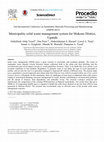
Procedia Manufacturing, 2019
Solid waste management (SWM) poses a great concern to researchers and academia globally. The resu... more Solid waste management (SWM) poses a great concern to researchers and academia globally. The result of inadequate waste disposal scheme threatens human settlement both in the urban and rural dwelling, and the environmental and social impact worsens as world population increases. There is no doubt that every person is an essential contributor to this problem. Regardless, to generate waste is one thing, the type of waste generated is another, and yet also the way it is generated, managed or disposed-off, entirely a different issue. The present study uses a quantitative research approach and collects data from Mukono town which is located within east of the central business district of Kampala. In this community, there are challenges of lean assets to administer their solid wastes, leading to unrestrained dumping, also poor management of wastes, thereby contributing to environmental pollution, and the spread of diseases, land degradation, and unhealthy living. The research evaluates, analyzed and characterizes the composition of the existing SWM practices in Mukono municipality. The results show that up to 50000 m 3 of composting landfill space is required to handle the solid waste disposal of not less than 25023.6 tons generated in Mukono district. The research also recommends ways to alleviate some of the present solid waste management concerns.
Conference Presentations by Danjuma Abdu Yusuf
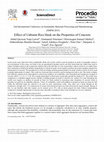
Conference , 2019
In the recent years, there have been considerable efforts all over the world to reuse by-products... more In the recent years, there have been considerable efforts all over the world to reuse by-products in order to sustainably conserve our environment. In this sense, rice husk is also an agricultural bi-product and its ash after being burnt has widely been used to replace Portland cement in the construction industry due to the fact that it is rich in pozzolanic content. However, no studies have been conducted to identify the definite temperatures to which rice husk can be heated to produce the perfect qualities required for enhancement of concrete. This prompted us to find out whether utilizing ground unburnt rice husk would as well be fit to be used in partial replacement of cement. This would save time and other resources used in heating rice husk to ash. This study evaluates how different contents of rice husk added to concrete may influence its workability, water absorption and compressive strength of concrete with 0, 1.5, 2.5, 5, 7.5 & 10% cement replacement at fixed water cement plus ground rice husk at 0.5. The results were compared to a controlled sample and the viability of adding ground rice husk to concrete was verified. For water absorption the results were negative as addition of ground un burnt rice husk resulted in increasing water absorption of concrete which is generally not good for its durability purposes. Values of workability varied with addition of ground un burnt rice husk but still within the allowable limits for concrete to be used on some construction works. Also, there was a break through on the compressive strength with 1.5% replacement of cement with ground un burnt rice husk achieving the target strength. Basing on this, we can therefore infer that cement can be reduced up to 15% with un burnt ground rice husk without compromising compressive strength requirements of concrete more especially in situations where water absorption is not very important.





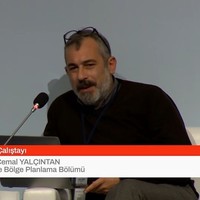





Uploads
Papers by Danjuma Abdu Yusuf
Conference Presentations by Danjuma Abdu Yusuf